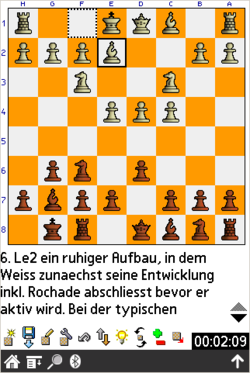OpenChess
| OpenChess
|
|
|---|---|
 OpenChess for PalmOS |
|
| Basic data
|
|
| developer | Olaf Richter |
| Current version | 3.00 (December 29, 2007) |
| operating system | Palm OS |
| category | Computer chess |
| License | GPL |
| German speaking | Yes |
| palmopenchess.sf.net | |
OpenChess is a chess front end for Personal Digital Assistants (PDA) from Palm Inc. and other comparable devices based on the Palm OS operating system . Palm OS version 3.0 or higher and at least two megabytes of memory are required. The program is developed as free software under the GNU General Public License . The current stable version is version 3.00, released in December 2007, and its predecessor version 2.0.1 is also available.
Technical aspects
Basic functions
The program offers the standard functions of a chess program such as saving and loading games, exporting to PGN format or entering positions for solving chess problems . In addition, it is equipped with a mode for training chess openings . It is available in language versions for English , French , German , Spanish , Portuguese , Italian , Dutch , Russian , Polish and Hebrew . From version 3, new sets of figures, language versions and opening books can be installed on the PDA in the form of individual files in addition to the main program. The graphic display is adapted to the technical possibilities of various Palm OS devices with regard to the resolution and color depth of the screen, so that the program can also be used on devices with black and white screens in low resolution.
Use of external engines
Version 2 of OpenChess combines a graphical user interface with the GNU Chess engine . In version 3, which has been available since December 2007, various freely available chess engines such as Fruit can also be used on devices with an ARM processor and Palm OS version 5 under OpenChess . The current version combines the functions of an independent chess program with those of a chess front-end . Supplied as external chess engines are Fruit in the last freely available version 2.1, the Toga II, which is derived from Fruit, in version 1.1a and the GambitFruit based on Fruit and Toga II in version 1.0, Beta 4bx, Phalanx in version XXII, Scorpio in the Version 1.6 and GNU Chess in version 2. The latter is functionally identical to the internal version, but due to the faster execution speed of the ARM program code, it is somewhat more playful in comparison. The porting of further engines is possible. The playing strength on a Palm Tungsten E2 in the BT2450 test is a BT Elo value of 1,688 for the internal engine, 1,852 for GNU Chess in the external ARM version, 2,303 for Toga II, 2,322 for Fruit, Gambitfruit and Phalanx as well 2,325 for Scorpio.
Historical information
Original version
The development of OpenChess was started by Son Altesse, who programmed a chess surface for Palm OS devices and, instead of developing a new chess engine, adapted GNU Chess, which already existed as free software, for use under Palm OS. The older version 2 of GNU Chess had the advantage that, due to its compactness, it was suitable for the limited memory of Palm devices and still offered an adequate playing strength.
After the release of version Beta 2 in September 2002, there was no further development by the supervisor of the program, various developers published modified versions, some under other names such as Handchess II. The authors tried to fix certain weaknesses in the original version to eliminate, especially the display that is very difficult to see on devices with monochrome screens. With 995 Chess, a commercial chess program was also published, which was derived from OpenChess.
In addition, under the name EbmChess, there is also a port of the original version published in February 2003 on the devices of the eBookMan platform from the American manufacturer Franklin Electronic Publishers .
Version 2
In February 2005, Version 2.0 Beta 1 appeared, the first edition supervised by Olaf Richter, which was based on the source code published by Son Altesse. Various bugs had been fixed in this version. In addition, it offered a graphic display optimized for different resolutions and color depths, as well as an opening trainer as a new function . After further beta versions , the final version 2.0 was released in May 2005. Version 2.0.1 followed about three months later, correcting a number of errors and including additional language versions for Italian and Dutch.
Version 3
The first beta version of version 3.0 was released in April 2006. Significant innovations were a reduction in memory requirements, support for the display options of new Palm devices, a display for the time per move, options for adapting the board display with new piece sets and the setting of the colors for the fields, and support for external chess engines on ARM -based devices with Palm OS 5. The Beta 1 version contained an ARM-optimized version of GNU Chess and version 2.1 of Fruit. The second beta version released in June 2006 contained, in addition to various bug fixes, four more ARM engines and support for other language versions. In the third beta version published in November 2006, various bugs were fixed and additional translations were added. After two versions called Release Candidates in January 2007 , which among other things contained ten different languages for the user interface and a new set of figures, the final version 3.00 was released in December of the same year.
Web links
- Official website (English)